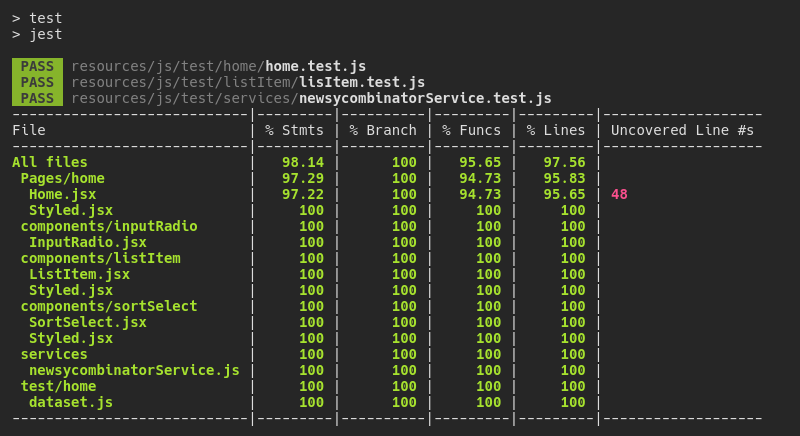This application is built in Laravel 9. These are the system requirements for the project:
- Nginx, Apache or any application server that can execute php.
- PHP 8.2.1
- PHP extensions: mb-string, curl, dom
- Node 16.14.0
You can clone the repository using this command: git clone git@github.com:hakenprog/web-scraper.git
Inside the project folder, run composer install
Then, create a .env. You can copy the .env.example file that comes in the repository.
Execute the following command: php artisan key:generate
In the .env file we only care about the following fields:
- APP_NAME=Laravel
- APP_ENV=local => You can change the env according to your needs
- APP_KEY= This key should have been generated with the previous command.
- APP_DEBUG=true => In production environments this option should be changed to false
- APP_URL=http://localhost => You can change this url according to your needs
- LOG_CHANNEL=stack
- LOG_DEPRECATIONS_CHANNEL=null
- LOG_LEVEL=debug
- BROADCAST_DRIVER=log
- CACHE_DRIVER=file
- FILESYSTEM_DISK=local
- QUEUE_CONNECTION=sync
- SESSION_DRIVER=file
- SESSION_LIFETIME=120
- MIX_WEB_SCRAPER_API_URL=http://127.0.0.1:8000/api/v1/newsycombinator => This URL will be used by the frontend to retrieve the data
Once we have the .env file with the correct configuration, we can run npm install.
Then execute npm run prod.
If everything is well configured, the project should run without any problem. If you have any error, be sure that you have APP_DEBUG activated, so Laravel can show some helpful information in the browser.
If you are in a local environment, you can execute a local server with php artisan serve.
In my experience, most of the problems are related with folders and files permissions.
Link to a working instance of the project: Example project
This project is running in a Debian Linux server with php 8.1.7 and node 14.9.3
The important files of the project are located inside de app folder, the services, the resources folder, and the tests folder.
Inside the app folder we have the Interfaces folder. Here I created three different interfaces, WebScraper, WebScraperErrorHandler, WebScraperFormatter. These interfaces are implemented in the files inside WebScrapers folder and the Services folder.
Laravel manages a powerful tool called service container. Using the service container, we can tell Laravel what implementation of the interfaces to use. For this purpose, Laravel follows the following structure. First, we have the service provider, that is located inside the app folder, in the Providers Folder. In my case, I created a WebScraperServiceProvider, that binds the interfaces to the implementations using the register method of the class. In the case that we want to use a different implementation depending on the context, Laravel has a "contextual binding". For instance, if we want to create another WebScraper, or just an implementation of any of the interfaces, we can choose where to use this new implementation using the WebScraperServiceProvider.
The Service Provider
The implementations of the interfaces are injected in other classes using the constructor. For example, in app > WebScrapers > NewsYCombinatorScraper, the WebScraperFormatter and the WebScraperErrorHandler are being injected using the Service Container.
NewsYCombinatorScraper Constructor (Dependency Injection in Laravel)
The WebScraperErrorHandler is in charge of handling possible errors that may occur during web scraping. If the same library (Goutte) is used, the current implementation could be used, or if necessary a new one could be created that meets the necessary requirements.
The WebScraperFormatter receives the data collected during the web scraping and returns it as an array, so that it can be used by the controller to respond to the requests. How the data is formatted depends entirely on the implementation of the interface as long as an array is returned.
The implementation of WebScraperErrorHandler and WebScraperFormatter can be found in the app > services folder.
Finally, inside the app > HTTP > Controllers folder, I created a WebScraperController. In this controller, I'm injecting a WebScraper implementation into the constructor. This class could be used as a base for new web scraper implementations. For example, the NewsYCombinatorScraperController is extending the WebScraperController. In the case that more WebScraperControllers are needed, we can tell Laravel what WebScraper implementation to use on each case using the WebScraperServiceprovider.
To communicate with the frontend, I used Inertia, that has a lot of useful methods for handling the integration with some frontend frameworks.
The frontend was developed using react. And for testing I used Jest and React Testing Library. For the backend, I used PHPUnit, that comes with Laravel.
To execute the testing in Laravel, just run the php artisan test command. Laravel will show a report in the terminal with all the relevant information. These tests are located in the tests folder, inside the root folder.
To execute the testing in the front end, run npm test. A report with the coverage and some useful information will be shown in the terminal. These tests are located in the resources > js > test folder.
Current results for PHPUnit Testing
Current results for Jest Testing






